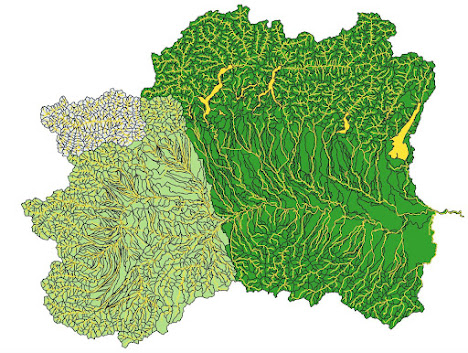Preparing for a CAMELS-Po dataset
CAMELS stand for Catchment Attributes and MEteorology for Large-sample studies. The clearest introduction is in Krazterk er al. It tells “Detailed datasets combining hydroclimatic time series, landscape attributes, and/or hydrological response variables like streamflow exist for many experimental catchments, in many cases spanning decades. … In parallel, there also exist tens of thousands of gauges monitoring rivers across the world. …. Gupta et al. argued that large sample sizes allow for assessment of the generality of hydrological models and research findings. Large sample sizes also allow for large-scale research like detecting and attributing systematic shifts in terrestrial water availability at regional to global scales. … Recognizing this has led to the development of a sub-discipline in the hydrological sciences called large-sample hydrology (LSH), which relies on data from hundreds to thousands of catchments”. (Please read the references for more information).

- Addor, Nans, Andrew J. Newman, Naoki Mizukami, and Martyn P. Clark. 2017. “The CAMELS Data Set: Catchment Attributes and Meteorology for Large-Sample Studies.” Hydrology and Earth System Sciences 21 (10): 5293–5313. https://doi.org/10.5194/hess-21-5293-2017.
- Alvarez-Garreton, Camila, Juan Pablo Boisier, René Garreaud, Jan Seibert, and Marc Vis. 2021. “Progressive Water Deficits during Multiyear Droughts in Basins with Long Hydrological Memory in Chile.” Hydrology and Earth System Sciences 25 (1): 429–46. https://doi.org/10.5194/hess-25-429-2021.
- Alvarez-Garreton, and Mendoza. 2018. “The CAMELS-CL Dataset: Catchment Attributes and Meteorology for Large Sample studies–Chile Dataset.” Hydrology and Earth System Sciences. https://hess.copernicus.org/articles/22/5817/2018/.
- Chagas, Vinícius B. P., Pedro L. B. Chaffe, Nans Addor, Fernando M. Fan, Ayan S. Fleischmann, Rodrigo C. D. Paiva, and Vinícius A. Siqueira. 2020. “CAMELS-BR: Hydrometeorological Time Series and Landscape Attributes for 897 Catchments in Brazil.” Earth System Science Data 12 (3): 2075–96. https://doi.org/10.5194/essd-12-2075-2020.
- Coxon, Gemma, Nans Addor, John P. Bloomfield, Jim Freer, Matt Fry, Jamie Hannaford, Nicholas J. K. Howden, et al. 2020. “CAMELS-GB: Hydrometeorological Time Series and Landscape Attributes for 671 Catchments in Great Britain.” Earth System Science Data 12 (4): 2459–83. https://doi.org/10.5194/essd-12-2459-2020.
- Delaigue, and Brigode. 2022. “CAMELS-FR: A Large Sample Hydroclimatic Dataset for France to Explore Hydrological Diversity and Support Model Benchmarking.” IAHS-2022. https://meetingorganizer.copernicus.org/IAHS2022/IAHS2022-521.html?pdf.
- Fowler, Keirnan J. A., Suwash Chandra Acharya, Nans Addor, Chihchung Chou, and Murray C. Peel. 2021. “CAMELS-AUS: Hydrometeorological Time Series and Landscape Attributes for 222 Catchments in Australia.” Earth System Science Data 13 (8): 3847–67. https://doi.org/10.5194/essd-13-3847-2021.
- Hao, Jin, Xia, Tian, and Yang. 2021. “Catchment Attributes and Meteorology for Large Sample Study in Contiguous China.” Earth System Dynamics. https://scholar.archive.org/work/fn4n5jgzlreyjfvjna2fklyo5a/access/wayback/https://essd.copernicus.org/preprints/essd-2021-71/essd-2021-71.pdf.
- Jehn, Florian Ulrich, Konrad Bestian, Lutz Breuer, Philipp Kraft, and Tobias Houska. 2019. “Clustering CAMELS Using Hydrological Signatures with High Spatial Predictability.” Hydrology and Earth System Sciences Discussions, April, 1–21. https://doi.org/10.5194/hess-2019-129.
- Klingler, Christoph, Karsten Schulz, and Mathew Herrnegger. 2021. “LamaH-CE: LArge-SaMple DAta for Hydrology and Environmental Sciences for Central Europe.” Earth System Science Data 13 (9): 4529–65. https://doi.org/10.5194/essd-13-4529-2021.
- Knoben, Wouter, and Martyn Clark. 2022. “CAMELS-Spat: Catchment Data for Spatially Distributed Large-Sample Hydrology.” Copernicus Meetings. https://doi.org/10.5194/egusphere-egu22-6609.
- Kratzert, Frederik, Daniel Klotz, Claire Brenner, Karsten Schulz, and Mathew Herrnegger. 2018. “Rainfall–runoff Modelling Using Long Short-Term Memory (LSTM) Networks.” Hydrology and Earth System Sciences 22 (11): 6005–22. https://doi.org/10.5194/hess-22-6005-2018.
- Kratzert, Frederik, Daniel Klotz, Guy Shalev, Günter Klambauer, Sepp Hochreiter, and Grey Nearing. 2019. “Towards Learning Universal, Regional, and Local Hydrological Behaviors via Machine Learning Applied to Large-Sample Datasets.” Hydrology and Earth System Sciences 23 (12): 5089–5110. https://doi.org/10.5194/hess-23-5089-2019.
- Ma, Kai, Dapeng Feng, Kathryn Lawson, Wen-Ping Tsai, Chuan Liang, Xiaorong Huang, Ashutosh Sharma, and Chaopeng Shen. 2021. “Transferring Hydrologic Data across Continents – Leveraging Data‐rich Regions to Improve Hydrologic Prediction in Data‐sparse Regions.” Water Resources Research 57 (5). https://doi.org/10.1029/2020wr028600.
- Siber, Rosi, Marvin Höge, Martina Kauzlaric, Ursula Schönenberger, Pascal Horton, Jan Schwanbeck, Daniel Viviroli, et al. 2022. “CAMELS-CH – Building a Common Open Database for Catchments in Switzerland.” https://doi.org/10.5194/egusphere-egu22-9859.
- Sterle, Perdrial, Li, and Adler. 2022. “CAMELS-Chem: Augmenting CAMELS (Catchment Attributes and Meteorology for Large-Sample Studies) with Atmospheric and Stream Water Chemistry Data.” Hydrology and Earth System Sciences. https://hess.copernicus.org/preprints/hess-2022-81/.
- Vasquez, Cepeda, and Gomez. 2019. “Exploring the Relation between Meteorological, Physiographic and Hydrological Similarities through Catchment Classification.” Geophysical and Astrophysical Fluid Dynamics. https://search.ebscohost.com/login.aspx?direct=true&profile=ehost&scope=site&authtype=crawler&jrnl=10297006&AN=140493270&h=NKYXshyG%2Bbu%2FK%2FLUfFm%2FEMY20NhOmBgJvpEtFInXc7Jkq9BHvL5fOilpNzcqVPISF9tBXQDvKfqoPbel4FIfNQ%3D%3D&crl=c.
- Wood, Eric F., Joshua K. Roundy, Tara J. Troy, L. P. H. van Beek, Marc F. P. Bierkens, Eleanor Blyth, Ad de Roo, et al. 2011. “Hyperresolution Global Land Surface Modeling: Meeting a Grand Challenge for Monitoring Earth’s Terrestrial Water: OPINION.” Water Resources Research 47 (5): 54. https://doi.org/10.1029/2010WR010090.
—————
TRANSCOM ISP – Free Sigma HSE Email
Level 6 Domain Names are FREE – Register Now.
